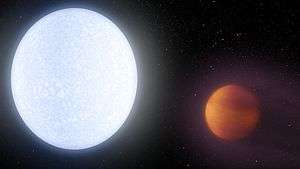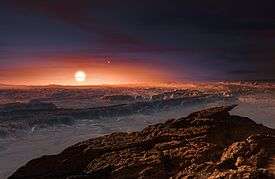KELT-9b
| Exoplanet | List of exoplanets | |
|---|---|---|
 | ||
| Parent star | ||
| Star | KELT-9 | |
| Right ascension | (α) | 20h 31m 26.35s[1] |
| Declination | (δ) | +39° 56′ 19.8″[1] |
| Spectral type | B9.5-A0[1] | |
| Mass | (m) | 2.52+0.25 −0.20[1] M☉ |
| Radius | (r) | 2.362+0.075 −0.063[1] R☉ |
| Orbital elements | ||
| Semi-major axis | (a) | 0.03462+0.00110 −0.00093[1] AU |
| Orbital period | (P) | 1.4811235±0.0000011[1] d |
| Inclination | (i) | 86.79±0.25[1]° |
| Physical characteristics | ||
| Mass | (m) | 2.88±0.84[1] MJ |
| Radius | (r) | 1.891+0.061 −0.053[1] RJ |
| Density | (ρ) | 530±0.15[1] kg m−3 |
| Temperature | (T) | 4050±180[1] K |
KELT-9b is the hottest gas giant exoplanet known, with a dayside temperature of between 4,050 and 4,600 K, which makes it hotter than M-type stars, and many K-type stars.[1] It orbits HD 195689 (or KELT-9), a late B-type main sequence star about 620 light-years (190 parsecs) from Earth.[1]
The host star has a temperature of 10,170 K, which is remarkable, as transiting planets are not usually detected in orbit of hot stars; as a reference, only six A-type stars were known to have planets prior to KELT-9b discovery (WASP-33, an A-type star with a temperature of 7,430 K being the hottest at the moment of the discovery of KELT-9b), and no B-type stars were known (hotter than A-type stars); KELT-9, classified as B9.5-A0[1] or A1[2], is the first B-type star (or, at least, almost B-type) in which a planet has been discovered.
KELT-9b was detected using the Kilodegree Extremely Little Telescope and the results of its unusual nature were published in 2017.[3][1]
The planet was found to have a largely extended hydrogen atmosphere[4]. The size of the atmosphere is close to the planetary Roche lobe, which implies the planetary atmosphere is escaping at a high mass loss rate. The discovery was made by probing the Balmer Hα line absorption when the planet is transiting in front of its host star[4].
It is tidally locked.[5]
The atmosphere of the planet is so hot that refractory elements that would usually be sequestered into molecules can exist as atomic species, including neutral and singly ionized atomic iron (Fe and Fe+) and singly ionized titanium (Ti+).[6]
References
- 1 2 3 4 5 6 7 8 9 10 11 12 13 14 15 16 Gaudi, B. Scott; et al. (5 June 2017). "A giant planet undergoing extreme-ultraviolet irradiation by its hot massive-star host" (pdf). Nature. 546 (7659): 514–518. arXiv:1706.06723. Bibcode:2017Natur.546..514G. doi:10.1038/nature22392. ISSN 1476-4687. PMID 28582774. Retrieved 2017-06-06.
- ↑ Jensen, K. S. (1981). "Spectral Classification in the MK System of 167 Northern HD Stars". Astronomy and Astrophysics Supplement. 45: 455. Bibcode:1981A&AS...45..455J. Retrieved 2018-08-18.
- ↑ Collins, Karen A.; Stassun, Keivan; Gaudi, B. Scott; Beatty, Thomas G.; Zhou, George; Latham, David W.; Bieryla, Allyson; Eastman, Jason D.; Siverd, Robert; Crepp, Justin R.; Pepper, Joshua (2016). "KELT-9b: A Case Study in Dynamical Planet Ingestion by a Hot Host Star". American Astronomical Society. 47: 204.03. Bibcode:2016DDA....4720403C. Retrieved 2018-08-18.
- 1 2 Yan, Fei; Henning, Thomas (2 July 2018). "An extended hydrogen envelope of the extremely hot giant exoplanet KELT-9b". Nature Astronomy. arXiv:1807.00869. Bibcode:2018NatAs.tmp...86Y. doi:10.1038/s41550-018-0503-3. ISSN 2397-3366. Retrieved 18 August 2018.
- ↑ NASA JPL, Pasadena CA (5 June 2017) Astronomers Find Planet Hotter Than Most Stars
- ↑ Hoeijmakers, H. Jens; Ehrenreich, David; Heng, Kevin; Kitzmann, Daniel; Grimm, Simon L.; Allart, Romain; Deitrick, Russell; Wyttenbach, Aurélien; Oreshenko, Maria; Pino, Lorenzo; Rimmer, Paul B.; Molinari, Emilio; Di Fabrizio, Luca (15 August 2018). "Atomic iron and titanium in the atmosphere of the exoplanet KELT-9b". Nature: 1. arXiv:1808.05653. Bibcode:2018Natur.560..453H. doi:10.1038/s41586-018-0401-y. ISSN 1476-4687. PMID 30111838. Retrieved 18 August 2018.
External links
| Wikinews has related news: Astronomers reveal discovery of the hottest gas giant exoplanet known yet |
- HD 195689 SIMBAD entry for HD 195689
- Astronomers Find Planet Hotter Than Most Stars at NASA Caltech

.jpg)
